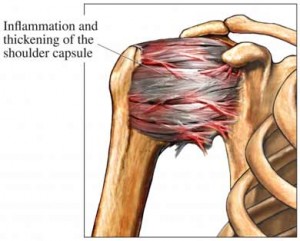 Frozen shoulder, or adhesive capsulitis, is a common condition that is often misdiagnosed and treated incorrectly as a result. The exact cause of frozen shoulder is unknown, it may occur out of the blue or after minor or significant trauma such as throwing a ball, reaching awkwardly, shoulder dislocations and acute rotator cuff tears. The condition is more commonly seen in woman between the ages of forty to sixty and the risk is particularly high for diabetics. However it is important not to let this criteria rule out diagnosis as cases have been seen in females and males of all ages.
Frozen shoulder, or adhesive capsulitis, is a common condition that is often misdiagnosed and treated incorrectly as a result. The exact cause of frozen shoulder is unknown, it may occur out of the blue or after minor or significant trauma such as throwing a ball, reaching awkwardly, shoulder dislocations and acute rotator cuff tears. The condition is more commonly seen in woman between the ages of forty to sixty and the risk is particularly high for diabetics. However it is important not to let this criteria rule out diagnosis as cases have been seen in females and males of all ages.
The shoulder joint is a ball and socket joint, the ball is the top of the arm bone (the humeral head), and the socket is part of the shoulder blade (the glenoid). Surrounding this ball-and-socket joint is a capsule of tissue. Normally, the shoulder joint allows more motion than any other joint in the body. When a patient develops a frozen shoulder, the capsule that surrounds the shoulder joint becomes contracted and bands of scar tissue called adhesions form. The contraction of the capsule and the formation of the adhesions cause the shoulder to become stiff and movement becomes painful.
 Some symptoms to look out for;
Some symptoms to look out for;
- Constant pain in the shoulder and down mid upper arm
- Pain worse at night that interrupts sleep
- Severe pain with sudden movement
- Stiffness (unable to reach up or to do up bra straps)
- Pain and stiffness that has progressively become worse
If left untreated frozen shoulder can take eighteen to twenty four months to heal, with specific osteopathic treatment recovery is much faster and full mobility could be achieved in two to four months. Manual treatment, use of pain relief and anti-inflammatory’s will usually be affective but occasional and severe cases may need surgery.
If you suspect you have frozen shoulder it is important to seek a medical professionals opinion. Peter Carter is our highly experienced osteopath, he can help diagnosis and treat frozen shoulder problems. An ultrasound, xray or MRI may be recommend to rule out other possible problems.
